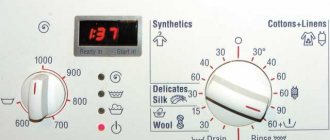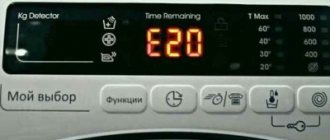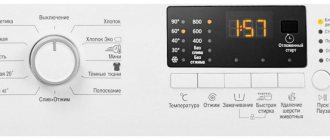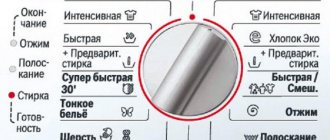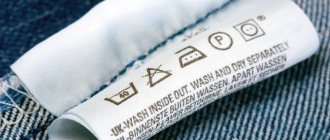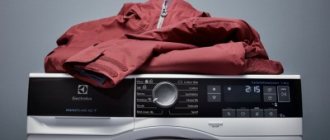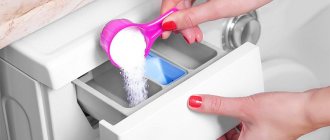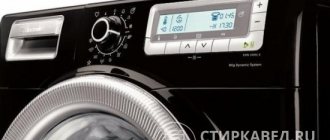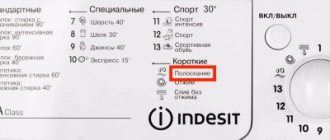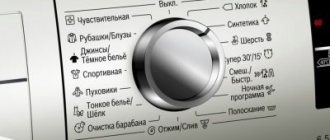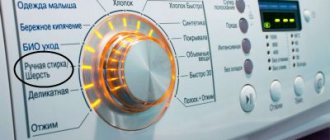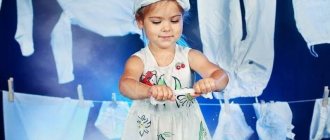Electrolux washing machines are popular and in demand in the domestic market, as they combine high quality with ergonomics and the ability to choose a device with the required characteristics.
For ease of use of the washing machine, you need to be aware of the manufacturer’s coding features.
We will look at the symbols on the Electrolux washing machine in the article.
Basic and additional icons: what do they look like and what do they mean?
Electrolux washing machines are high-tech modern household appliances with an attractive design. Some settings symbols are immediately clear to the user, others require decoding.
The main ones include the following:
- The symbol looks like a basin with an “I” icon inside, and indicates pre-wash; the same symbol is present on one of the powder receptacle compartments.
- The symbol depicting a basin with the “II” icon inside is the main wash.
- The spiral symbol is spin.
- Icon of a bowl of water with light jagged waves on the surface - rinsing.
- A basin filled with water – stop rinsing.
- A basin that has no bottom and an arrow drawn underneath it indicates draining water from the tank.
- The stylistic image of the door in the form of a vertical line and an arrow means the end of the cycle.
Additional icons on the case are also very informative.
Their number and type depend on the model and configuration, and therefore differ on devices. The most common include:
“TIMER NN”, where NN indicates the time in hours by which the start can be delayed;- “Very quiet” - for models with low noise levels;
- “N kg” - N – number of kilograms for maximum load;
- an icon depicting a bowl of water and an arc above it means additional rinsing;
- a square icon inside of which there is a circle and an arc with a double-headed arrow means imbalance control;
- schematic image of an iron in a square - easy ironing for straightening things in the drum;
- square with a picture of water and bubbles – foam control.
Washing programs can also be marked with icons:
- Schematic illustration of a cotton box - for washing cotton items.
- Test tube means washing synthetic fabrics.
- The sketchy flower is a delicate treatment.
- T-shirt pattern with stains - wash on intensive cycle.
- ECO – environmentally friendly washing.
- Butterfly – for washing silk.
- A skein of thread - for washing wool.
- 5 shirts – the mode is suitable for a small number of lightly soiled items, washing is carried out at a temperature of 30°C.
- Sneakers - for caring for sports shoes, synthetic clothing and refreshing things, the duration of the entire cycle is 30 minutes.
- Trousers - this symbol corresponds to the washing program for denim and dark fabrics at a temperature of no more than 60°C.
- The “blanket” icon indicates a washing program for bulky items with filling, varying the temperature within 30-60°C.
- Curtains – a program for washing curtains and drapes with water heated to 40°C and a cycle duration of 100 minutes, including pre-wash (which does not require detergent).
- Water basin and palm - hand wash.
It’s convenient when the washing machine body has both a symbolic image and a verbal description of the mode. This allows you to quickly navigate the selection of programs when starting a work cycle.
Video review of the Electrolux washing machine:
Groups of symbols on a washing machine
All of the above images can be divided into 4 main groups.
Group number one includes icons that display the washing progress:
- Regular wash.
- Prewash.
- Washing mode.
- Add. rinsing.
- Spin.
- Drain.
- Drying.
- End of washing.
On different displays you can find additional icons with individual functions such as “rinse softening” or “rinse delay”, which is associated with the individual functionality of the base of a particular type of equipment. Standard type designations have the same interpretation.
The 2nd group of signs shows those modes that are intended for certain types of fabric. The key difference is in the temperature and speed of the drum during washing and spinning.
The symbols on the washing machine that are most often used:
- Jeans.
- Silk.
- Synthetics.
- Jeans.
- Wool.
The third group usually includes those modes that you can use at your own discretion:
- Items with stains.
- Handwash.
- Economy wash.
- Delicate fabrics.
- Night wash.
- Quick wash.
- Active washing.
- Children's toys and things.
- Personal hygiene items.
- Curtains.
In addition, it is worth noting that manufacturers are simply exhausted by the desire to add a new icon to this group.
Thus, the capabilities of washing machines are growing every day to improve the quality of washing and increase competitiveness. In the fourth group, each washing machine icon has its own button. This in itself is a group of additional functions that can include these programs in addition to washing.
In the fourth group, each washing machine icon has its own button. This in itself is a group of additional functions that can include these programs in addition to washing.
Very often it turns out that icons from the third group are dragged into the 4th, and vice versa.
Let’s assume that if in one machine there will be a separate mode from the first one, then in another model from another manufacturer it will be a mode under a separate button and this will be an additional function.
But, as a rule, the panel contains the following list of symbols:
- Wrinkle resistance.
- Reduced washing time.
- Reducing the number of revolutions.
- Control of foam formation.
- Using more water.
In addition to the above symbols on the washing machine, there is a way to select the washing temperature and the spin speed of the drum.
Top stores of washing machines and household appliances:
- mvideo.ru/—home appliance store, large catalog of washing machines
- holodilnik.ru – Inexpensive store of household appliances.
- techport.ru - profitable modern online store of household appliances
- citilink.ru is a modern online store of household appliances and electronics, cheaper than offline stores!
- ru.aliexpress.com—spare parts for washing machines
Useful options
In addition to the main modes, the Electrolux washing machine provides a number of additional options:
- Direct Spray - spraying laundry with water to prevent wrinkles;
- Child protection – allows you to block the control panel from children and accidental settings;
- Steam System - steam treatment, which allows you to refresh things and prevent them from becoming wrinkled during processing;
- Time manager is an option that makes it possible to lengthen or shorten the duration of the processing cycle, but this setting can only be used in a limited number of modes;
- Aqua Control – notification when there is a water leak.
Nuances when starting washing for the first time
When buying a new washing machine, you want to try the device in action as quickly as possible. First of all, you need to make sure that the connection and installation are correct. If you make any mistakes, it can lead to water leakage or even breakdown. It is necessary to check that the machine is stable and that there are no foreign objects in the drum.
After purchasing a new machine, the question arises what the icons on the washing machine mean. To do this, you need to study the instructions in detail, and in the absence of them, study the relevant articles on the Internet.
Electrolux washing machine model marking coding
Each Electrolux washing machine model has its own coding. The set of letters and numbers encrypts the basic information about the technology, and it is not at all difficult to understand it.
The encoding of the current models that are currently on sale is as follows:
- In all TM Electrolux washing machines, the letter “E” is written first. This is the first letter of the word "Electrolux".
- The second symbol is always the letter “W”, which indicates that this is a washing machine.
- The third character is a number that indicates the series of the washing machine. For example, it would be “6” for the PerfectCare 600 series and “7” for the PerfectCare 700 series.
- Another letter in the encoding allows you to determine the type of washing machine:
- G – built-in;
- S – frontal, with a narrow body (up to 46 cm);
- W – washer-dryer;
- T – top loading;
- F – front loading;
- N – drying equipment with a heat pump;
- C – condensation type dryer.
- Two characters define the control type. For example, "4R", "3R".
- Maximum spin speed (coding corresponds to drum revolutions per minute):
- 0 — 1 000;
- 2 – 1 200;
- 4 – 1 400;
- 6 – 1 600.
- Maximum load of laundry into the drum (in kilograms).
- The color of the washing machine (from the name in English, by the first letter). For example, W is white.
- Type of motor in the washing machine.
The type of marking of Electrolux washing machines was changed in 2017. In older models the encoding was different.
Electrolux company
The company's assembly plants are located in several countries around the world, including:
Despite the wide geographical location of the company’s production sites, all products of this brand, without exception, are manufactured in compliance with all standards and quality requirements for equipment of this kind, which is confirmed by numerous positive reviews from users of various purposes and types of equipment of the above-mentioned brand. One of the core areas of the Electrolux concern is the production of high-tech automatic washing machines, individual models of which we will discuss in our article.
Error codes
The washing machine generates information about operating errors and failures automatically . The corresponding code is shown on the display. This allows you to quickly respond to a stop in work and easily find a unit that has stopped working normally.
The error code, depending on the specific model, may look like “ERROR”, “ERR” or “E”. Following the letter designation is a code that indicates what kind of trouble has occurred with the automatic washing machine, and which unit should be paid attention to during diagnostic measures.
Electrolux errors that may be seen on the display:
- E10 / E11 - no water supply, the waiting time for water supply has been exceeded (the reason may be not only a blockage, but also a failure of elements on the control board);
- E13 – leak;
- E20 / E21 / EF0 / EF1 – drain error (blockages, malfunctions, failures);
- E23 / E24 – drainage violation, faulty triacidac;
- E31 – E34 – pressure switch malfunction;
- E50 – E55 – motor malfunction;
- E52, E56, E59 – malfunctions of the tachogenerator installed on the motor;
- E57, E58 – high voltage in the network;
- E61, E62, E66, E68, E69, E3A, E71, E74 – errors related to water heating (including heating element failures, malfunctions, sensor failure, etc.);
- E40 – E45 – errors associated with the hatch door;
- E90 – E91 – problems with the control module;
- EF5 – imbalance;
- EH3 – network voltage is too low;
- EH1 – voltage is not normal;
- EH2 – network voltage is too high;
- EF2 – increased foam formation.
In some cases, error codes may alternate on the display if multiple nodes are involved in the failure. Some problems can be fixed even on your own, while others may require serious diagnostics and professional repairs.
Error codes for the Electrolux washing machine are discussed in the video:
Video
We offer you to watch a video on the topic of the article.
She graduated from the author's physics and mathematics lyceum and art school. Received a higher education in economics with a major in innovative management. Freelancer. Married, actively travels. He is interested in Buddhist philosophy, enjoys transurfing and loves Mediterranean cuisine.
Found a mistake? Select the text with the mouse and click:
Stretch ceilings made of PVC film can withstand from 70 to 120 liters of water per 1 m2 of their area (depending on the size of the ceiling, the degree of its tension and the quality of the film). So you don’t have to worry about leaks from neighbors above.
Fresh lemon is not only suitable for tea: clean dirt from the surface of an acrylic bath by rubbing with half a cut citrus, or quickly wash the microwave by placing a container of water and lemon slices in it for 8-10 minutes at maximum power. The softened dirt can simply be wiped off with a sponge.
The dishwasher cleans more than just plates and cups. You can load it with plastic toys, glass lamp shades and even dirty vegetables, such as potatoes, but only without using detergents.
The habit of using an automatic washing machine “sparingly” can lead to the appearance of an unpleasant odor in it. Washing at temperatures below 60℃ and short rinses allow fungi and bacteria from dirty clothes to remain on internal surfaces and actively multiply.
The easiest way to remove scale and carbon deposits from the soleplate of the iron is with table salt. Pour a thick layer of salt onto the paper, heat the iron to maximum and run the iron over the salt bed several times, applying light pressure.
Threads made of gold and silver, which were used to embroider clothes in the old days, are called gimp. To obtain them, the metal wire was pulled for a long time with pliers to the required fineness. This is where the expression “to drag out the rigmarole” came from - “to do long, monotonous work” or “to delay the completion of a task.”
Before removing various stains from clothing, you need to find out how safe the selected solvent is for the fabric itself. It is applied in a small amount to an inconspicuous area of the item from the inside out for 5-10 minutes. If the material retains its structure and color, you can move on to stains.
There are special traps to combat moths. The sticky layer with which they are covered contains female pheromones that attract males. By sticking to the trap, they are eliminated from the reproduction process, which leads to a decrease in the moth population.
If your favorite things show the first signs of gestation in the form of untidy pellets, you can get rid of them using a special machine - a shaver. It quickly and effectively shaves off clumps of fabric fibers and returns things to their proper appearance.
